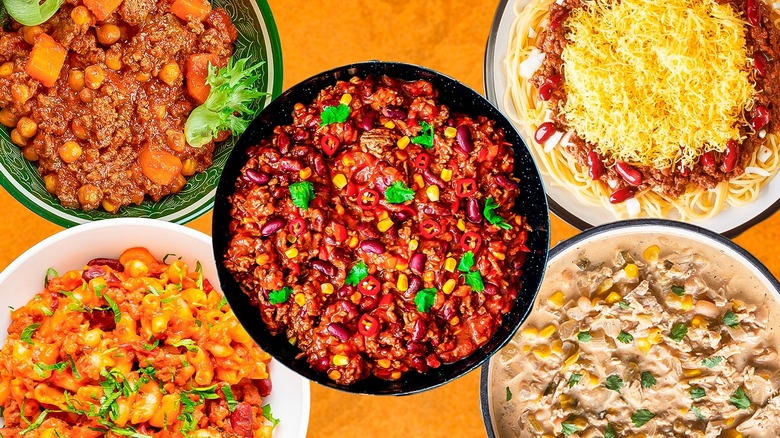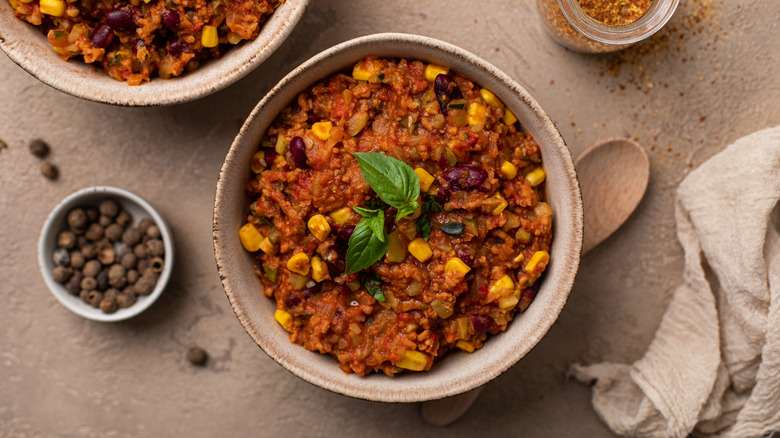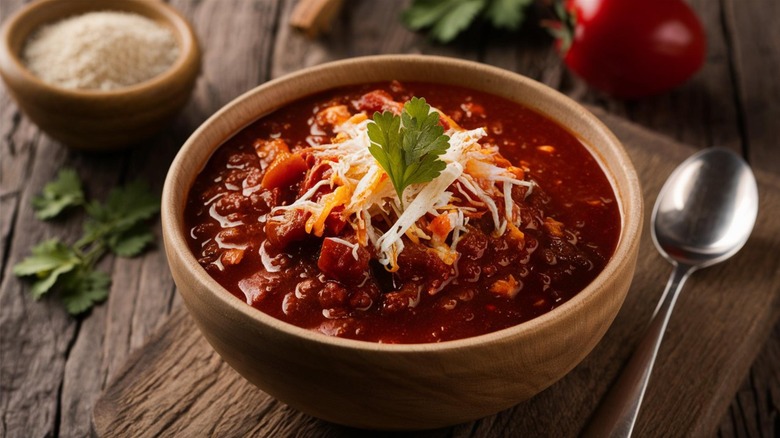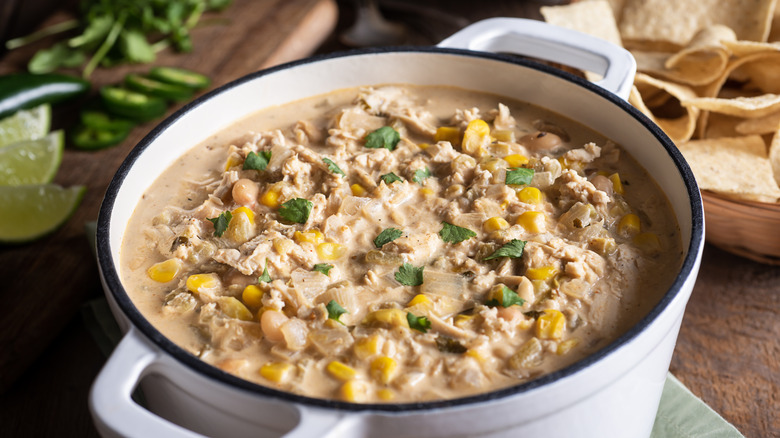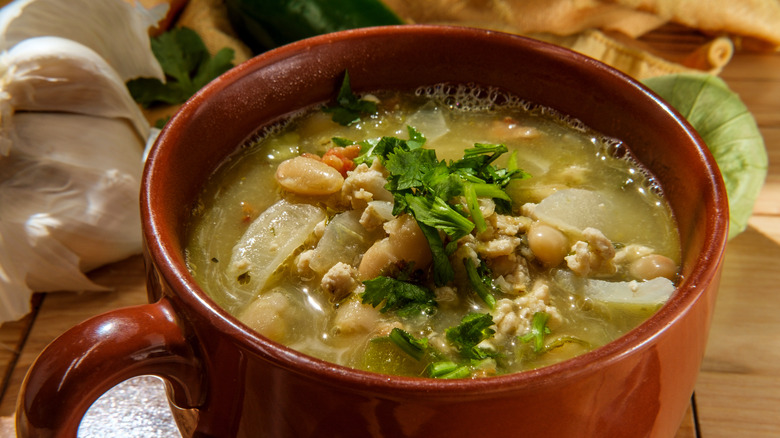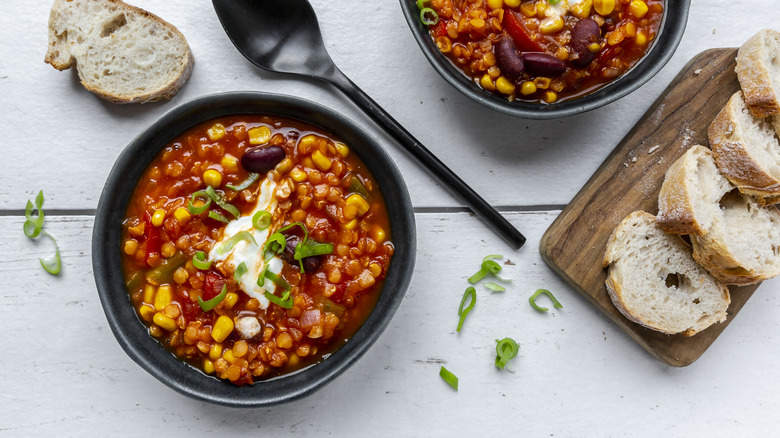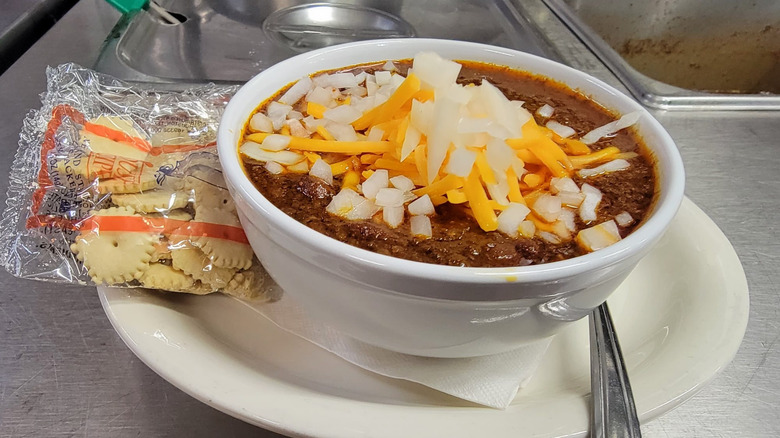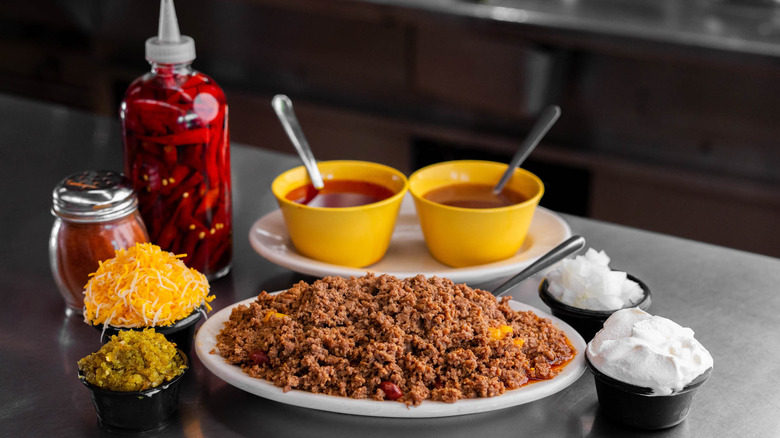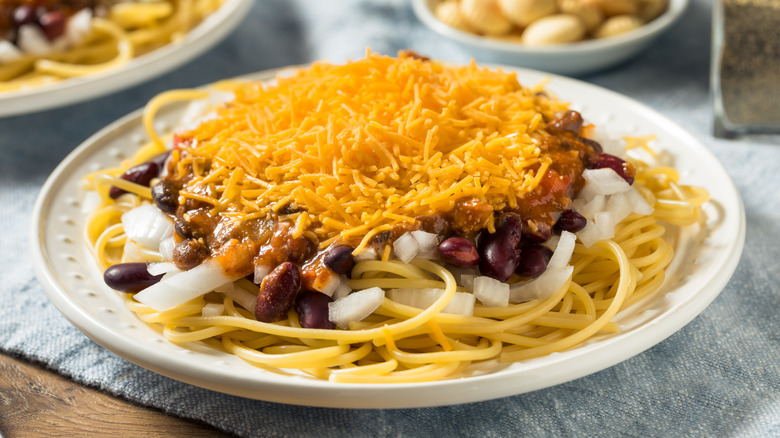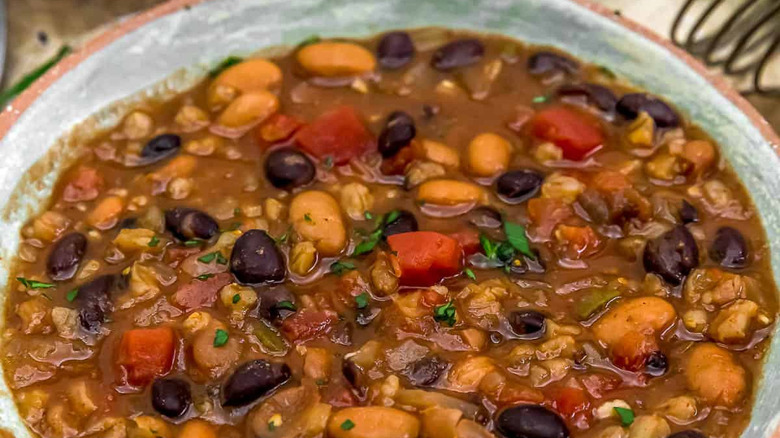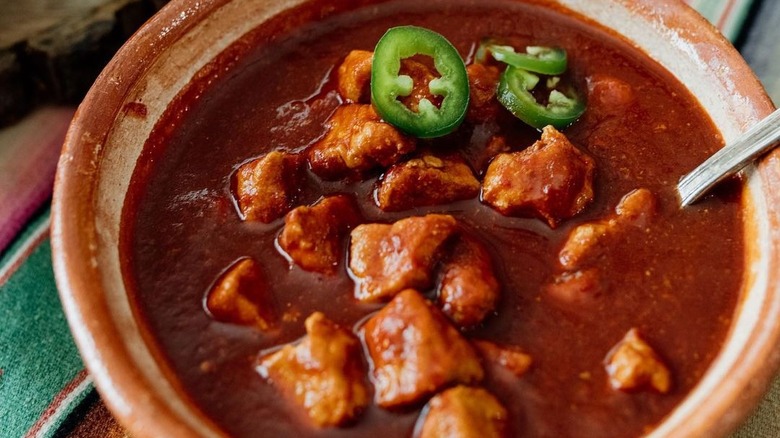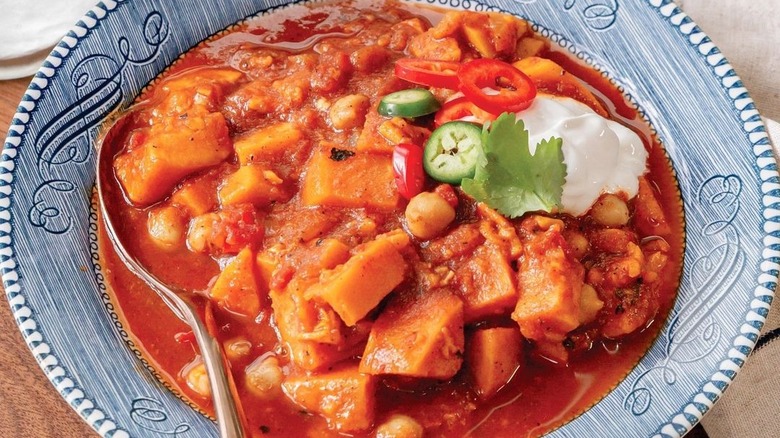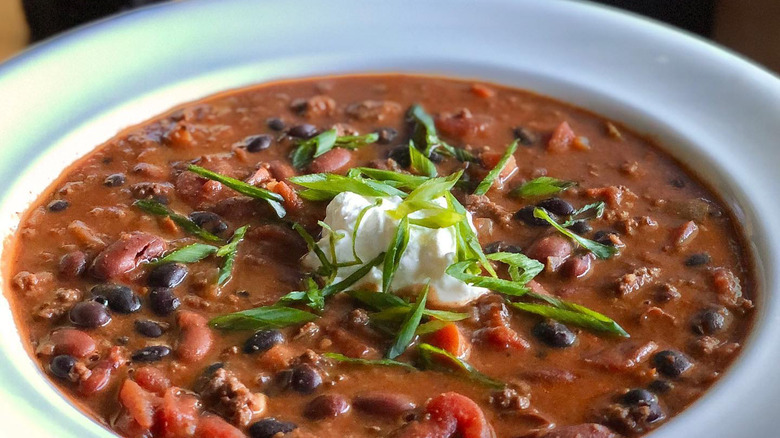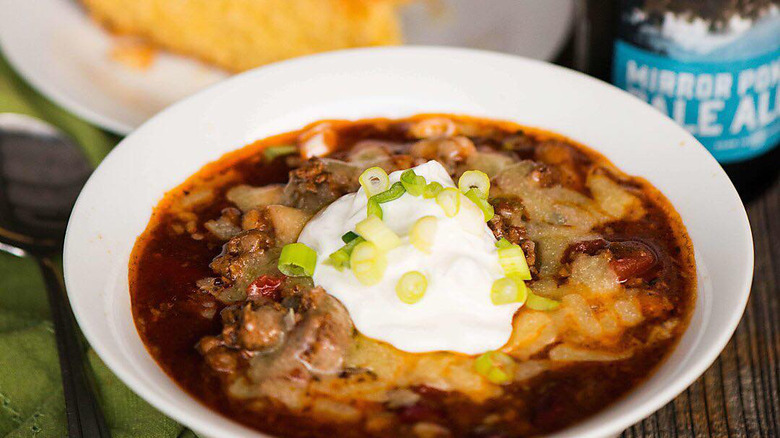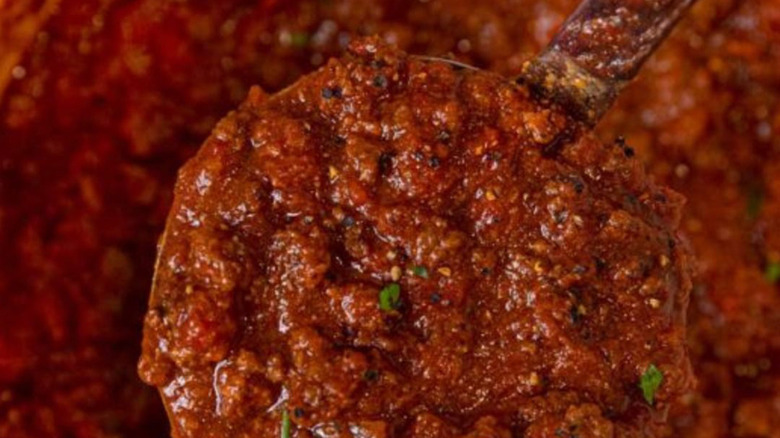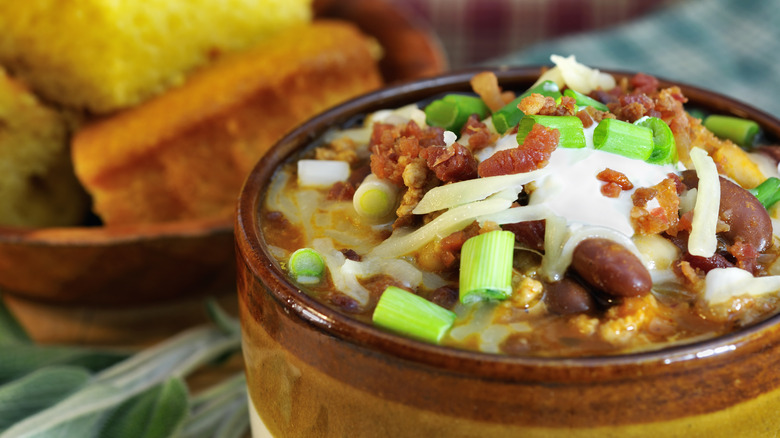16 Types Of Chili, Explained
There are few dishes more comforting than chili. It's hearty, filling, and packed with flavor — what's not to love? Chili is also delightfully easy to prepare from scratch, making it ideal for beginner home cooks. What's more, chili tends to feature filling ingredients, so you can be sure it's a satisfying dish.
But how is chili defined? In general, chili is a stew that typically consists of ground meat and chili peppers, and often contains beans, tomatoes, and spices. The exact ingredients and spices vary by type and region, but the use of chili peppers is what makes chili, well, chili. The peppers can be fresh, dried, or powdered, depending on which of the many chili recipes you're following, and what ingredients you have handy. Regardless of the type of chili you're making, there are certain things to keep in mind to ensure your dish is a success. First, be sure to use the freshest chili peppers and seasonings you can find, which is key for a delicious chili. Another one of the tips to know that will elevate your chili is to cook it low and slow. The low temperature will avoid drying out the meat, while the slow heat will reduce the acidity of the tomatoes.
Chili is thought to have originated in Texas, and was created with inspiration from Mexican, Spanish, and Native American cuisines. However, people around the country and world have put their own spins on this specialty, as proven by this collection of chili varieties.
Chili con carne
When translated from Spanish, "chili con carne" translates to "chili with meat", and this version of the dish is probably what comes to mind for most people when they think of chili. A Tex-Mex specialty, chili con carne is believed to have originated in San Antonio, Texas. In fact, it's the official state dish of Texas, a title bestowed upon the meaty dish in 1977.
As the name suggests, chili con carne contains meat, which is typically beef. Otherwise, the ingredients of this dish can vary widely. The most basic version contains chili peppers and tomatoes, and it can be made with or without beans. Depending on the recipe, chili powder might be used in place of whole dried peppers, but the latter ingredient will always yield the most delicious results. Don't be afraid to mix and match different types of spicy peppers, as this will add flavor to your dish.
Texas chili
Texas chili is considered to fall under the category of chili con carne, as it traditionally features beef chuck cooked with chili peppers. The dish is sometimes called "Texas red chili," while a serving is known as a "bowl o' red." But unlike many chili recipes, Texas chili doesn't get its red hue from tomatoes — because it contains no tomatoes at all. Instead, this variety is made with beef, spices, and a generous helping of chili peppers, and the latter ingredient imparts a deep red color.
Tomatoes aren't the only ingredient missing from Texas chili. This recipe also omits beans, which Texans believe have no place in chili. Adding tomatoes and beans in the Lone Star State would be considered a culinary crime you should never commit with Texas chili.
While beans do add thickness and bulk in other chili versions, this doesn't mean that Texas chili is lacking in either department. This dish includes chili pepper paste, which is made by rehydrating and blending an assortment of dried pepper pods. Since Texas red calls for zero tomatoes, the overall texture is less soupy than other chili varieties. The result is a thick, stew-like dish that's packed with heat and flavor.
White chili
White chili is a creamier and brighter variety of this dish. It lacks the red color of Texas-style chili because it contains no red chili peppers, or tomatoes either. In general, white chili is made with beans, broth, chicken, corn, and green chili peppers. This is frequently prepared as a milder version of chili, which might be ideal if you're not a fan of intensely spicy flavors.
White chili is also lighter than traditional red chili, as it is usually made with chicken, which is leaner than beef. You can use ground or diced chicken — or if you're looking for a tasty shortcut, try shredded rotisserie chicken. Ground or shredded turkey also works well for white chili. In fact, this is an excellent dish for using up leftover Thanksgiving turkey, as the broth in the chili prevents the meat from drying out.
For its signature white broth, white chili needs some kind of dairy ingredient. Sour cream and heavy cream are commonly used, but you can also use cream cheese, Greek yogurt, or plain milk. If you're looking for a dairy-free version, try making this chili with plant-based yogurt or unsweetened coconut milk.
Chili verde
A dish traced back to Mexico, chili verde is particularly popular in the American Southwest. "Verde" is Spanish for "green," and this type of chili gets its name because it contains tomatillos instead of red tomatoes. If you're unfamiliar with tomatillos, they look like small green tomatoes — but don't let their appearance fool you. While tomatillos are related to tomatoes, they're technically a different type of produce. Tomatillos are smaller and tangier than standard red tomatoes. Tomatillos also have a papery husk that needs to be peeled before you use them.
Another difference between chili verde and red chili comes down to the meat. Chili verde is generally made with chunks of pork, rather than beef. Otherwise, the steps for making chili verde are similar to other chili recipes: brown the meat in a pot, then add onions, garlic, spices, and chili peppers. Add chopped tomatillos and broth, then simmer until the spiced concoction thickens. Alternatively, for a deeper flavor, you can roast the tomatillos first.
Chili mac
This comfort food is essentially chili with elbow pasta and cheese — or, put another way, macaroni and cheese made with chili. Because of the pasta addition, chili mac is heartier than regular chili, making it perfect for chilly nights and weeknight dinners. Plus, chili mac can be customized based on your dietary preferences and what ingredients you have on hand, just like standard chili.
The easiest way to make chili mac is to prepare your go-to chili recipe, then mix in cooked elbow pasta and a few cups of shredded cheese as the final step. Cheddar cheese is a classic option, but you can use other types of cheese as well. The cheese will melt into the warm chili, coating the pasta in a thick and gooey sauce that can't be beat.
Vegetarian chili
When chili is prepared without meat, it's known as vegetarian chili. This type of chili typically uses more beans than other versions, as it's often the primary source of protein in the dish. As with other varieties of chili, kidney beans are fair game, as well as black, white, or pinto beans. Feel free to mix and match popular types of beans, or, if you're looking to switch things up, use lentils or chickpeas.
You can also make a veggie-friendly quinoa chili recipe that's especially filling, because it's packed with protein and fiber, and the quinoa adds a meat-like texture to the dish. Another option is to add sweet potatoes to vegetarian chili, as the tubers provide a hearty creaminess. The trick is to cut the sweet potatoes into small cubes, then add them to the chili just before you start simmering the broth. By the time the chili is done cooking, the sweet potatoes should be fork-tender.
Springfield chilli
This type of chili hails from Springfield, Illinois, a city that calls itself the "Chilli Capital of the World" (and no, that's not a typo — in Springfield, folks spell chili with the extra "l"). Served in multiple eateries across the state capital, this regional style of chili is often made with beef, beans, bacon, beer, and mild spices. What's more, the beans are prepared separately and mixed into the dish just before serving.
Look at a bowl of Springfield chilli, and you might notice a layer of grease on top. This is from its secret ingredient: beef suet, aka fat, a staple ingredient in the dish. Suet adds flavor, texture, and liquid, but you don't necessarily need to use a lot of it to get that iconic Springfield chilli flavor. When making this variety, feel free to substitute some of the suet with oil — and don't forget the oyster crackers, diced onions, and shredded cheese, which are traditional toppings for the dish.
Kansas City chili
In Kansas City, Missouri, the ingredients found in chili may vary, but beef brisket and pulled pork are often included, along with the region's sweetly unique barbecue sauce. When brisket is used, the chili typically features the burnt ends, which are a barbecue staple in Kansas City.
When making this type of chili, consider how it's served at Dixon's Famous Chili, a legendary restaurant in Independence, Missouri. Operating since 1919 — and counting President Harry Truman as a customer, who enjoyed his chili slathered on tamales — Dixon's offers a DIY approach to chili, allowing customers to order the dish with extra meat juice or bean broth. The toppings also vary, ranging from ketchup and jalapeño relish to onions, pickles, and grated cheese. Dixon's also offers chili served on a bed of spaghetti, or you can make the meal presidential with a side of tamales.
Cincinnati chili
Classic Cincinnati chili is the brainchild of Tom and John Kiradjieff, a pair of brothers who immigrated from Europe in the early 1920s. After arriving in Cincinnati, Ohio, the brothers opened up the Empress chili parlor, where they created a Mediterranean-style chili made with spices like cinnamon, nutmeg, cloves, and chili powder. Some versions even call for cocoa powder, which is added to elevate the natural flavor of the beef while balancing the spices. All that said, the addition of warm spices and chocolate is what makes Cincinnati style chili so unique.
Another defining feature of this regional chili is that the original recipe contains zero beans. However, it's perfectly acceptable to serve beans as a topping, along with finely diced raw onions, grated cheddar cheese, and oyster crackers. It's also often served on spaghetti, though you can certainly enjoy it on its own in a bowl or on a hot dog. You might also hear Cincinnati chili called Skyline chili, thanks to the popular Cincinnati-based restaurant of the same name.
Moroccan chili
If you're craving a break from American-style chili, try a Moroccan version. Featuring a delicious blend of North African flavors, Moroccan chili often includes paprika, carrots, tomatoes, onion, and lamb or beef, although meat-free recipes are common, too. It also usually calls for spicy harissa, a smoky and piquant paste made with chili peppers, garlic, and olive oil. Harissa is a traditional ingredient found in Moroccan cuisine, providing a bright red color and deep, peppery flavor. The best part: Harissa can be made with varying levels of spiciness, so you can choose a variety that best suits your taste buds.
Another inclusion that distinguishes Moroccan chili from other varieties is chickpeas, aka garbanzo beans. Like kidney beans in other varieties of chili, chickpeas are excellent for adding plant-based protein and providing a hearty texture that can complement the meat you're using. Alternatively, if making a vegetarian or vegan batch of Moroccan chili, you can use extra chickpeas, and also add kidney beans. For even more Moroccan and North African inspiration, consider adding ingredients like golden raisins, couscous, cinnamon, or a topping of fresh cilantro.
Carne adovada
A traditional dish in New Mexico, carne adovada is also known as red chili pork. Like the region's chili verde, carne adovada is a chunky stew that's less soupy than other varieties of chili. To make it, cubed pork is marinated in a red chili sauce for 24 hours, then slow-cooked for several hours. The red chili sauce is what sets this dish apart from other types of chili, as it's specifically made with dried red chili pepper pods, a staple ingredient of New Mexican cuisine.
Many recipes for carne adovada use sweeteners, like honey or molasses, to balance the spicy kick of the red chili sauce. Just be sure to avoid adding too much sweetener, as it can tone down the iconic chili pepper flavor. Another common ingredient in carne adovada is vinegar, which gives the dish a tangy brightness. In New Mexico, carne adovada is frequently served with tortillas, though it's also delicious as a burrito filling.
Cajun chili
Meat lovers, this one's for you. Batches of Cajun chili are often prepared with two or three different types of meat, such as pork, beef, chicken, and Southern andouille sausage. If you're unfamiliar with this sausage, it's made with smoky pork and spiced with Cajun seasonings. These links are a quintessential Louisiana ingredient, making the sausage right at home in Cajun chili. However, you can certainly make the dish without sausage and use other meats instead.
Another distinct feature of this chili is its inclusion of Cajun cuisine's sacred mirepoix with a key ingredient swap. Instead of the usual French combination of diced carrots, onions, and celery, Cajun mirepoix — also called the "holy trinity" — replaces the carrots with green bell peppers, and this serves as an important flavor base for many recipes in Louisiana, including Cajun chili. Lastly, this version of chili isn't complete without Cajun seasoning, a blend traditionally made with paprika, cayenne pepper, garlic powder, onion powder, black pepper, and white pepper. Some versions of this spice combo also include cardamom, cumin, or chipotle pepper, which adds a smoky touch to the blend.
Chorizo chili
Chili can also be made with chorizo sausage, resulting in a flavorful and spicy meal. But first, it's worth noting that you can choose to use either Spanish or Mexican chorizo. While both consist of spiced pork, the differences between them are significant. Spanish chorizo is cured and typically sliced, much like salami. Since it's ready to eat, you're more likely to find it on a charcuterie board rather than in a hot dish like chili. On the other hand, Mexican chorizo is sold raw and cooked like ground beef, making it more appropriate for chili, as well as other soups and stews.
Typically, chorizo is paired with other meats when used in chili. The most common option is ground beef, though you can also increase the amount of beans. The ground beef or extra beans will help complement the spicy notes of chorizo, resulting in a more balanced dish. Alternatively, you can easily make a meat-free version of chorizo chili by using "soyrizo" (chorizo made of soy) and beans.
Game day chili
When it comes to game day, beer and chili are two staple items. But have you ever had beer in chili? Also known as game day chili, this variety uses beer as a liquid component, creating a rich depth of flavor. Adding beer to chili is easy: Pour it in the pot at the same time as the broth, then simmer until the liquid is thick and reduced. The heat will cook off the alcohol, but the nutty richness of the beer will remain in the dish.
It's worth noting that you don't have to use high-end beer for game day chili; inexpensive beer will do. Additionally, dark beer is often recommended for chili, as the robust flavor of the drink will complement the meatiness of the dish. Ground beef is the meat of choice for most game day chili recipes, but you can also use ground pork, veal, or turkey.
Oklahoma chili
Oklahoma-style chili is similar to Texas chili. The exception is that beans are acceptable and allowed in neighboring Oklahoma, which is thought to be a nod to the regional cuisine of the Sooner State. Another deviation from Texas chili is the use of tomatoes, which the Oklahoma version often contains in the form of tomato sauce and diced canned tomatoes. In other words, there are plenty of possible variations for chili in Oklahoma, especially as this dish draws inspiration from other neighboring states like New Mexico and Missouri, each of which has unique styles of chili.
But if there's one thing that makes Oklahoma-style chili unique, it's the inclusion of masa. A traditional ingredient in Mexican cuisine, masa is a type of flour made of corn. When used in chili, masa absorbs the liquid, ultimately thickening the dish. It also adds a subtle corn flavor that works well with this chili's tomatoes and spices.
Turkey chili
Ground turkey may not be a standard ingredient in chili, but it's becoming a more common component of this dish. That's because it's leaner than pork, beef, and chicken, making it a great alternative if you want a meat-based chili with less fat. What's more, ground turkey is available in different levels of leanness — including a 99% fat-free option — so this inclusion can be customized to suit varying dietary preferences. If you don't eat red meat, ground turkey is an excellent substitute for a hearty and meaty chili.
Due to its leanness, ground turkey can be bland and boring if it's not cooked right. Of course, adding it to a spicy pot of chili is a great start, but there are several tips you need when cooking with ground turkey to ensure that your entire dish is packed with flavor. It's important to brown the turkey before adding it to a chili recipe, so that it develops an optimally caramelized meaty flavor. Also, consider using more spices and seasonings than usual, as turkey tends to be less flavorful than fattier meats.
